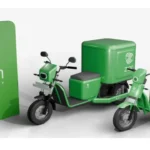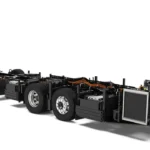Key Highlights:
- In June FY24 the E4W sales notices a dip in sales with declining 12.67% (MoM)
- The Indian E4W records a low sales figure of 6,888 units in June FY24
- Tata Motors continues to lead the graph with a sales of 4,346 units in June FY24
The EV industry of India registers a surge in sales, with an impressive growth of 9,27,097 units in the first half of FY24 (January-June), marking a significant incline of 20.73% compared to the same timeline in FY23. This increasing graph is dominated by the electric-two-wheeler (E2W) segment, recording a sales tally of 5,56,091 units during H1, FY24, accounting to approximately 58% of overall sales (E2W) hit in previous fiscal-year.
However, electric-four-wheeler (E4W) category shares, a major contribution in the growth of this sales chart, holding a year-on-year (YoY) growth rate of 21% in H1, FY24 with a milestone of 46,694 units. Although, the month of June disrupts this continuous trend, reporting a decline of 12.67% month-on-month (MoM) and 11.40% decline of a year-on-year (YoY) in the total sales.
June FY24’s data observed an inclusive sales of 6,888 units, which is 2,units lesser in comparison to May FY24, though this was also a decrease of about 1.34% as opposed to April FY24, yet it’s a laudable numbers achieved in the month of June. In June FY23, the electric-four-wheeler (E4W) segment in India, recognized a business of 6,888 units, alongside a decline of month-of-month (MoM) 12.67% and rising year-on-year (YoY) change, by 11.40% in June FY23, which highlights to shrinking figures by 886 units in June FY24.

Here is a pie chart representing the differences in electric four-wheeler sales for June FY24 (6888 units), May FY24 (7887 units), and June FY23 (7774 units). The chart highlights the following differences:
- June FY24 vs May FY24: 999 units
- June FY24 vs June FY23: 886 units
- May FY24 vs June FY23: 113 units
| (E4W) OEM | Jun’24 | May’24 | Jun’23 | MoM% | YoY% |
| TATA MOTORS PASSENGER VEHICLES LTD | 4,346 | 5,083 | 5,485 | -14.50% | -20.77% |
| MG MOTOR INDIA PVT LTD | 1,405 | 1,441 | 1,160 | -2.50% | 21.12% |
| MAHINDRA & MAHINDRA LTD | 446 | 564 | 413 | -20.92% | 7.99% |
| Citroen India PVT LTD | 236 | 86 | 336 | 174.42% | -29.76% |
| BYD INDIA PVT LTD | 229 | 163 | 185 | 40.49% | 23.78% |
| HYUNDAI MOTOR INDIA LTD | 61 | 96 | 160 | -36.46% | -61.88% |
| BMW INDIA PVT LTD | 50 | 72 | 100 | -30.56% | -50.00% |
| MERCEDES-BENZ AG | 41 | 57 | 37 | -28.07% | 10.81%- |
| VOLVO AUTO INDIA PVT LTD | 41 | 35 | 44 | 17.14% | -6.82% |
| KIA INDIA PVT LTD | 15 | 21 | 39 | -28.57% | -61.54% |
| AUDI AG | 15 | 6 | 7 | 150.00%- | 114.29% |
| Others | 9 | 14 | 5 | -35.71% | 80.00% |
| Total | 6,894 | 7,638 | 7,971 | -9.74% | -13.51% |
With this concerning monthly sales report of June, 2024 Tata Motors continues the tradition of leading the (E4W) OEM sales graph, followed by other two dominating players, ranking in top positions dominating a large section of Indian EV Industry in the sphere of Passenger Mobility Solutions.
Tata Motors Retains Its Top Position:
Tata Motors succeeded in achieving the most sales figure, compared to other electric-four-wheeler (E4W) OEMs in the market, hitting a target of 4,346 units in June FY23, however these numbers are concerning, in contrast to May FY24’s, 5,083 units and around same time period, last fiscal-year, which went all across 5,485 units.
This accounts for -14.50% month-on-month (MoM) and -20.77% year-on-year (YoY) change, with a hold on more than 63.1% of market-share in Indian EV Industry i.e. a major decline, relative to the H1, FY24 dominance by 67.1 %. Nevertheless, these stats are only portrayal of Tata’s superior position.
A burgeoning portfolio of four cars, shares an equal contribution in keeping Tata on top position of the competitive EV market in passenger mobility category in India. This squad comprise of segment-leaders such as, Tiago.ev, Tigor.ev, Punch.ev and Nexon.ev, which is likely to be joined by upcoming introductions as follows; Curvv.ev, Harrier.ev and Sierra.ev.
MG Motors Ranks Second In The Race:
MG Motors, retains its second position in the Passenger Mobility EV category of India, with total sales of 1,405 units in June FY24. These figures are not much less, compared to May FY24’s 1,441 units, though a decrease of 36 units also counts to a decline. However, in contrast to June FY23, these numbers are commendable with an inclining difference of 245 units. In June FY24, MG Motors noticed a dipping month-on-month (MoM) change of 2.50%, accompanied by a growing 21.12% of year-on-year (YoY) difference.
MG Motors currently distributes this position, with two EVs available in its portfolio; ZS EV and Comet EV, although this line-up is about to expand with the three more confirmed launches slated between end of 2024 to mid of 2025, which goes as Binguo EV, Magic EV and a micro-SUV underpinning Comet EVs platform.
Mahindra Holds a Prominent Position Amongst Top Players In EV Race:
Mahindra ranks third in top EV positions of Passenger Mobility Category. This achievement could have been possible with a sales target of 446 units in June FY24, which in comparison to May FY24, is a declining figure by 118 units, although these numbers stands apart, relative to June FY23, which observed a sales of 413 units. The June FY24’s report, noticed a month-of-month (MoM) sales decline of 20.92%, yet a year-on-year (YoY) rise of 7.99%. Mahindra’s portfolio accounts sole EV, behind this success and the Indigenous brand’s significant spot in the world third largest auto market’s electric transition; XUV 400. Therefore even a third position wouldn’t be considered bad for Mahindra. Although, the XUV 400 will get a company of two distinct series hosting multiple models in EV range, expected to arrive by next fiscal year.
The Verdict:
India’s path to becoming a major player in the global EV industry is clear despite recent declines. The entry of new players and expansion of EV infrastructure across cities will be pivotal. With two Indian manufacturers securing top positions in the EV race, India’s potential to lead the global EV market is evident. As new entrants join, EV sales in India will likely rise. Monthly sales depend on various factors, but the future of mobility is undoubtedly electric, spanning mid-range to premium solutions.






